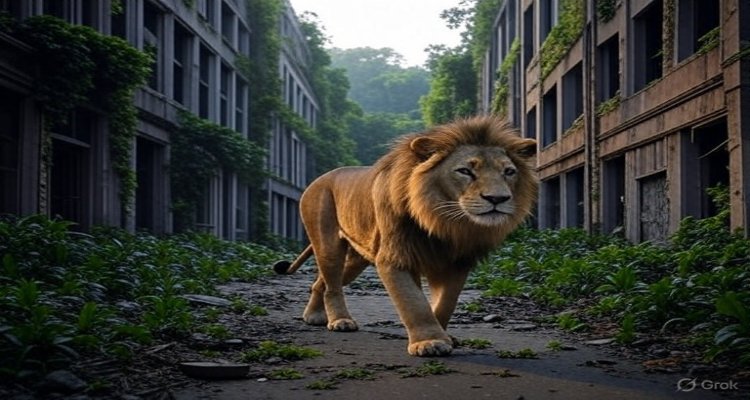How Animals Are Reclaiming Abandoned Cities
As human activity retreats from once-vibrant urban areas, wildlife is moving in. Discover how animals are reclaiming abandoned cities and reshaping ecosystems.
Introduction: When Silence Returns to the Streets
In streets once busy with car horns and neon lights, a new sound echoes—birdsong. What was once urban jungle is slowly becoming a true jungle again. Across the globe, abandoned cities, ghost towns, and derelict industrial districts are being claimed by animals. From deer strolling through deserted avenues to birds nesting in crumbling high-rises, these places offer a rare glimpse into how nature adapts when humans step aside.
Context & Background: A World of Forgotten Cities
Urban abandonment is not a new phenomenon. Over time, cities have been left behind due to war, natural disasters, industrial collapse, or migration. Famous examples include:
-
Pripyat, Ukraine, deserted after the Chernobyl disaster in 1986, where wolves, bears, and lynx roam freely.
-
Detroit, USA, where large swathes of depopulated neighborhoods now harbor foxes, falcons, and coyotes.
-
Varosha, Cyprus, a once-thriving resort town evacuated in 1974, now echoing with seabirds and wild plants.
In many cases, what was seen as urban decay for humans has become fertile ground for ecological revival. Gradually, ecosystems rebuild themselves, and wildlife replaces human habitation.
Main Developments: How Animals Are Transforming Empty Cities
When human activity retreats, cities don’t simply “die.” Instead, they evolve—often in surprising ways:
-
Predators Return: Wolves, coyotes, and wild boar are increasingly reported in deserted districts, no longer threatened by cars, crowds, or noise.
-
Birdlife Flourishes: With fewer disturbances, birds of prey like hawks and owls hunt freely across abandoned rooftops and crumbling factories.
-
Vegetation Breaks Through: Cracks in sidewalks and empty gardens become natural corridors for insects, rabbits, and reptiles. Lush greenery attracts larger herbivores over time.
-
Marine Life Reclaims Waterfronts: In abandoned port cities, dolphins and seals venture closer to shore, while fish spawn in quiet harbors once clogged with ships.
Far from being static ruins, abandoned urban spaces evolve into thriving habitats, creating complex food webs where pigeons, foxes, and even apex predators coexist.
Expert Insight: Nature’s Urban Comeback Story
“Abandoned cities are like accidental wildlife sanctuaries,” says Dr. Elena Markovic, an ecologist specializing in urban ecosystems. “They show us how quickly nature regenerates when the pressures of human presence are lifted. Within a decade, a city can transition into a semi-wild forest ecosystem.”
Public sentiment also reflects curiosity and awe. Social media users frequently share captivating images of deer grazing in deserted courtyards or owls nesting in collapsing stairwells. For many, these sightings spark conversations about coexistence and humanity’s impact on the natural world.
Impact & Implications: What Does This Mean for Humans?
The resurgence of wildlife in abandoned cities brings both hope and challenges:
-
Hope for Conservation: Ghost towns illustrate the resilience of ecosystems and provide living laboratories to study wildlife recovery.
-
Urban Policy Questions: Should abandoned districts be converted into rewilding projects, protected reserves, or redeveloped for future human use?
-
Potential Risks: Increased presence of predators or disease-carrying animals in nearby regions may create conflicts when urban borders blur with wilderness.
-
Cultural Shifts: Seeing animals thrive where humans once lived challenges our perception of “progress,” forcing us to rethink how cities should coexist with nature.
The trend raises a profound question: Are abandoned spaces temporary wastelands or future blueprints for ecological cities?
Conclusion: A Future Written by Pawprints and Wingbeats
From owls nesting in clock towers to boars roaming cracked highways, animals reclaiming abandoned cities remind us of nature’s quiet power. For humans, these places may represent loss or history, but for wildlife, they are opportunities for survival.
The lesson is clear: when the concrete jungle grows silent, the natural jungle always returns. Future urban planning may benefit from this truth, designing greener, more biodiverse cities where both people and wildlife can thrive together.
Disclaime:This article is intended for educational and informational purposes. Wildlife behavior can vary depending on region and conditions. Observations mentioned are based on documented ecological studies and public reporting.











